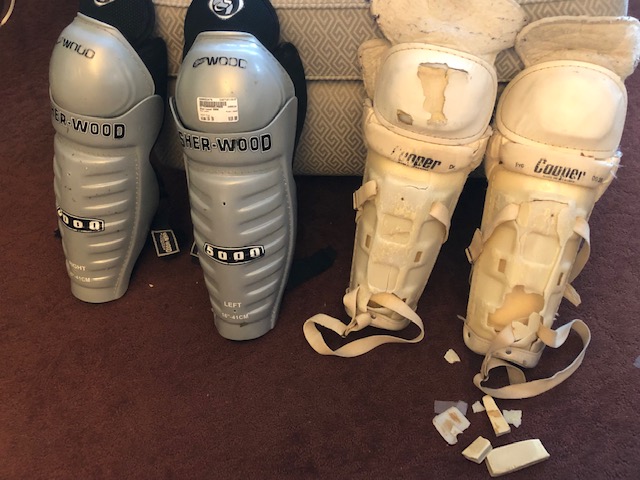There is a standard play in ice hockey known as a “deke.” I don’t usually link to Wikipedia as a primary source, but in this case it will service just fine. According to the summary:
In ice hockey, a deke is a type of feint or fake technique whereby a player draws an opposing player out of position or skates by the opponent while maintaining possession and control of the puck. The term is a Canadianism formed by abbreviating the word decoy.
I never considered how clever writers can also use dekes in their stories. Then I came across a quick Facebook post, by Chuck Laszewski, who was a reporting colleague when I was at the St. Paul (Minnesota) Pioneer Press. We both grew up in northern Wisconsin and landed careers in Minnesota, where ice was central to winter culture. I let go of my ice skates at some point — something Laszewski never did. He recently turned 67, but he remains a passionate hockey player.
His post carried the photo above, of two pairs of shin guards — one shiny, sleek and silver and the other battered, discolored white. The brief story with the photo:
I purchased the white hockey shin pads back in 1978. They have seen a lot of use by me and a couple of years by my brother Greg when he played in a Milwaukee league. This morning, the combination of old age and below zero temps spelled the end. A hard pass struck me at shin level. I didn’t feel it, but the pad shattered. I purchased the sleek new gray pads this afternoon. So long, good and faithful protectors.
One paragraph — a full mini-story that I once heard a writer call a “nano-narrative.” When I got to the third sentence, the reference to “old age and below zero temps” felt like a perfect foreshadow to “the end” that was coming: Laszewski finally had to accept that it was time to quit the game.
But no! He executed a deke. Laszewski wasn’t retiring himself, but his shin guards.
It’s a delightful little example of keeping a reader engaged by setting them up for an expected destination, then surprising them with a different reveal.
It requires discipline — you don’t want them to jerk them around too often, too long or without relevance. The feint has to be a fair to the story. Example: Laszewski’s post wouldn’t have worked if his story wasn’t connected to his own age and to the sub-zero temps. But when it works, it makes the reader part of the story. They are on the story path with you, the writer — and then find themselves somewhere new, wondering where the story will take them next.
PS: The photo tells more of the story, adding to the interest: No straps visible on the new shin guards, crumbly styrofoam padding and a litter of band-aids on the floor by the old ones. I wish Laszewski many more happy years on the ice.



